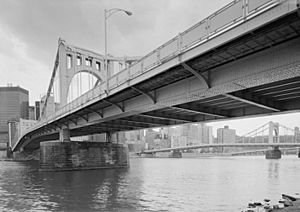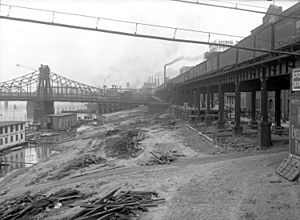Andy Warhol Bridge facts for kids
Quick facts for kids Andy Warhol Bridge |
|
|---|---|

From north bank of the Allegheny River, looking southwest, downtown Pittsburgh in background, Roberto Clemente Bridge at right. Shows main plate girder (bearing compressive forces) and sidewalk support.
|
|
| Coordinates | 40°26′46″N 80°00′05″W / 40.44611°N 80.00139°W |
| Carries | Seventh Street |
| Crosses | Allegheny River |
| Official name | Andy Warhol Bridge |
| Named for | Andy Warhol |
| Maintained by | Allegheny County |
| Characteristics | |
| Design | Suspension bridge |
| Total length | 1,061 ft (323 m) |
| Width | 62 ft (19 m)Vertical clearance above 78 ft towers |
| Height | 83.5 ft (25.5 m) |
| History | |
| Constructed by | American Bridge Company |
| Construction begin | 1925 |
| Construction end | 1926 |
| Opened | June 17, 1926 |
| Lua error in Module:Location_map at line 420: attempt to index field 'wikibase' (a nil value). | |
The Andy Warhol Bridge, also known as the Seventh Street Bridge, is a famous bridge in Pittsburgh, Pennsylvania. It crosses the Allegheny River right in downtown. This bridge is special because it's the only one in the United States named after a visual artist.
It first opened on June 17, 1926. The cost to build it was about $1.5 million. Around 2,000 people came to celebrate its opening day.
Contents
Why the Name Andy Warhol?
The bridge was renamed for the famous artist Andy Warhol on March 18, 2005. Andy Warhol was born in Pittsburgh. This renaming was part of the tenth anniversary of The Andy Warhol Museum. The museum is very close to the bridge. It's located at 117 Sandusky Street, which leads right to the bridge from the north side of the river.
The Three Sisters Bridges
The Andy Warhol Bridge is one of three similar bridges in Pittsburgh. They are known as The Three Sisters. The other two are the Roberto Clemente Bridge and the Rachel Carson Bridge.
These three bridges are very important in history. They are the only group of nearly identical bridges in the U.S. They were also the first "self-anchored suspension bridges" built in the country. This means their main cables are attached to the bridge itself, not to the ground.
A Brief History
The Andy Warhol Bridge is actually the third bridge built in this spot. The first bridge was taken down in early 1884. A new one started being built in 1884 and was ready for traffic by 1887. The current bridge, which we call the Andy Warhol Bridge, was completed in 1926.
Knit the Bridge Project
On August 11, 2013, something really cool happened at the bridge. It was covered with 580 knitted and crocheted panels! This art project was called "Knit the Bridge." It was a type of "yarn bombing." The colorful display stayed on the bridge for four weeks.
Gallery
Images for kids








